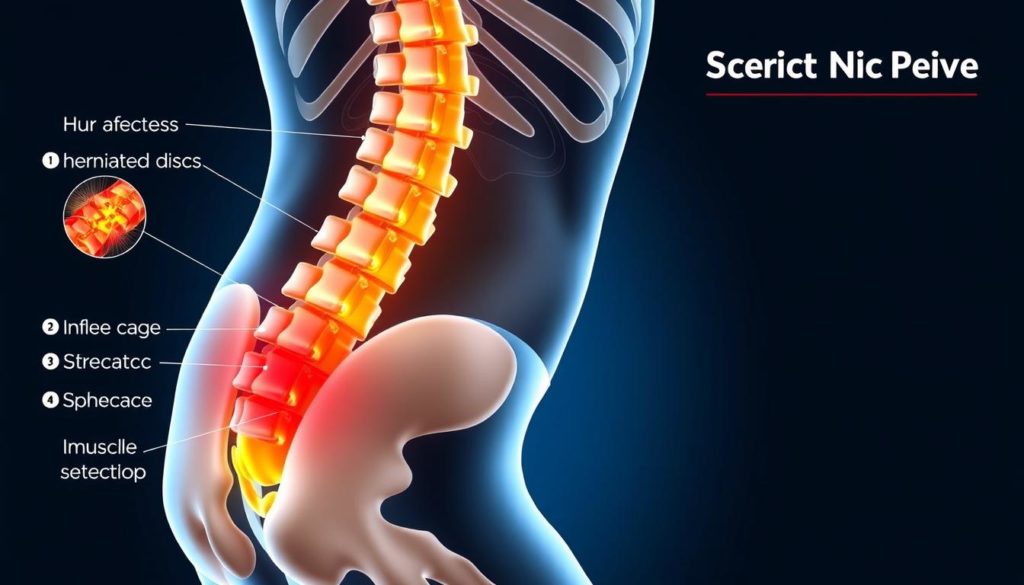Sciatica can be a real headache with its unexpected burning, numbness, or sharp pains. Thankfully, sciatica pain relief tips exist to ease the discomfort. If you’re seeking quick solutions for how to relieve sciatica pain fast or sciatica treatment at home, you’ve come to the right spot. This article is packed with helpful advice to reduce your discomfort and improve your health.
The root of sciatica pain often lies in a slipped disk or a bone spur pressing on the nerves. Dealing with this pain is easier with some gentle stretches, exercise, and specific home care tips. These strategies can greatly ease your pain, starting your journey to feeling better.
Understanding Sciatica: Causes and Symptoms
Sciatica is when the sciatic nerves are pressed, causing pain from the lower back to legs. It happens due to sciatica causes like a slipped disk, bone spur, or spinal stenosis. These issues press on the nerve, causing pain and urging the need for effective solutions.

It’s vital to know how to manage sciatica symptoms for relief. Symptoms usually are:
- Burning or tingling sensation in the lower body
- Numbness or weakness in the leg or foot
- Intense, sharp pain in the buttock area
Understanding these symptoms is the first step towards finding natural remedies for sciatica pain. Tackling these signs early can greatly enhance life quality for those with sciatica.
The Role of Physical Activity in Managing Sciatica Pain
Being active is key to managing sciatica pain. It helps make you more mobile and eases muscle tension. Adding the right exercises for sciatica into your daily life can reduce pain and keep your spine healthy. Let’s look at the top exercises for sciatica and how to include them in your day.
Benefits of Gentle Movements
Gentle movements are great for people with sciatica. They stretch the lower back, boost blood flow, and stop muscles from getting stiff.

Doing these exercises every day keeps you flexible and strong. This is important for getting rid of pain in the long run.
Recommended Low-Impact Exercises
Choosing the right low-impact exercises is crucial when you have sciatica. Here are some good choices:
- Walking: It’s a simple exercise that keeps you active without hurting your back.
- Swimming: This gives you a full workout and supports your back softly.
- Yoga: Certain yoga poses focus on the lower back and relieve tension.
How to Incorporate Movement Into Your Routine
Adding movement to your routine can be easy. Follow these steps to get started:
- Begin with short walks and slowly walk further as you feel better.
- Plan regular times for swim or yoga to stay on track.
- Pay attention to your body and adjust your exercises to avoid pushing too hard.
If you keep up with these exercises, you’ll manage sciatica pain better and feel healthier overall.
Effective Sciatica Stretches for Immediate Relief
For those dealing with sciatica pain, adding targeted sciatica stretches can offer big relief. These stretches help ease muscle tension and lessen nerve compression. They also boost flexibility.
Reclining Pigeon Pose
The Reclining Pigeon Pose is an effective stretch that opens the hips and reduces nerve pressure. To do this stretch, lie on your back. Cross one leg over the opposite thigh. Then, gently pull the uncrossed leg to your chest. Hold this position for a bit to let the tension melt away.
Knee to Opposite Shoulder Stretch
The Knee to Opposite Shoulder Stretch is also great for sciatica relief. Lie on your back to start. Bring one knee to your chest. Slowly pull it across your body to the opposite shoulder. This stretch loosens the piriformis muscle, which provides immediate relief from sciatica.
Standing Hamstring Stretch
Doing the Standing Hamstring Stretch stretches your hamstrings and lower back. Stand with feet hip-width apart, bend forward from the hips, and reach for your toes. This stretch doesn’t just offer relief. It also helps with flexibility, which is key in how to relieve sciatica pain fast.
Making these sciatica stretches part of your everyday routine can really help your comfort and how easily you move. By doing these stretches regularly, you can get immediate relief from sciatica symptoms.
Hot and Cold Therapy: When and How to Use It
Hot and cold therapy for sciatica helps reduce pain and speed up recovery. Knowing when to use hot or cold therapy is key for managing sciatica pain well.
Cold Therapy for Initial Pain
Use cold therapy for new or sudden sciatica pain. Ice packs or cold compresses can reduce swelling and ease sharp pain. It’s most helpful in the first 48 hours after symptoms start.
Transitioning to Heat Therapy
After the first 72 hours, it’s good to switch to heat therapy. Heat pads or warm towels relax tight muscles and boost blood flow. This helps with ongoing stiffness and muscle recovery.
Alternating Between Hot and Cold
Using both hot and cold therapy offers the best of both worlds. This method lowers inflammation and eases muscle spasms. It’s a well-rounded way to relieve sciatica pain and better your life.
Over-the-Counter Medications for Sciatica Pain
Managing sciatica pain can benefit from over-the-counter meds. Nonsteroidal anti-inflammatory drugs (NSAIDs) are especially popular. They reduce inflammation and help with sciatica pain relief.
Common NSAIDs and Their Effects
NSAIDs like ibuprofen and naproxen reduce inflammation by blocking certain enzymes. This eases sciatica pain and discomfort. You can easily find these meds at pharmacies or stores. They’re good for short-term relief, but remember to stick to the recommended dose.
Important Considerations and Precautions
OTC meds can help with sciatica but have possible side effects. Long-term use might cause issues for the stomach, heart, and kidneys. Before starting any new drug, talk to a healthcare provider to make sure it’s safe for you. For more on sciatica pain relief and treatments, check this comprehensive guide.
The Benefits of Physical Therapy for Sciatica
Physical therapy is very effective for sciatica pain. It offers tailored exercise plans. These focus on fixing bad posture and strengthening lower back muscles.
Creating a Personalized Exercise Plan
A personalized sciatica exercise plan targets specific muscles to ease pain. It boosts flexibility, improves activities, and betters body mechanics.
| Key Components | Purpose |
|---|---|
| Manual Therapy | Relieve tension and improve muscle function |
| Stretching Exercises | Enhance flexibility and reduce muscle tightness |
| Nerve Glides | Reduce nerve irritation and improve mobility |
| Low-Impact Aerobic Exercises | Enhance cardiovascular health and support weight management |
Improving Posture and Strengthening Muscles
Improving posture is key in treating sciatica with physical therapy. Core strengthening exercises build a strong base. This supports the spine, easies pain, and helps prevent future issues.
Keeping up with a sciatica exercise plan enhances posture, strength, and mobility. It ensures a better life quality.
Sciatica Pain Relief Tips
For quick relief from sciatica, practicing proper seating posture is key. Pick chairs that support your lower back. Avoid sitting for too long. Remember, stand and stretch often. This helps blood flow and eases pressure on the sciatic nerve.
Adding gentle exercises to your day helps a lot. Try yoga, swimming, or walking. These activities make muscles stronger and increase flexibility. Doing them often brings quick and long-lasting relief.
Heat and cold therapy is another great approach. Start with cold packs to lessen inflammation and ease sharp pain. Then, after a few days, switch to warm compresses or heating pads. This hot and cold treatment can really help at home.
The table below shows these sciatica pain relief techniques. It helps you see their benefits and how to quickly ease sciatica pain:
| Technique | Description | Benefits |
|---|---|---|
| Proper Seating Posture | Use chairs with good lower back support. | Reduces pressure on the sciatic nerve. |
| Regular Stretching | Stand up and stretch intermittently throughout the day. | Improves blood flow and flexibility. |
| Gentle Exercises | Incorporate yoga, swimming, or walking into your routine. | Strengthens muscles and reduces pain. |
| Heat and Cold Therapy | Use cold packs initially, then switch to heat after a few days. | Reduces inflammation and soothes pain. |
By using these sciatica treatment at home tips from experts, you can learn how to relieve sciatica pain fast. This ensures you stay comfortable and mobile for the long run.
Benefits of Massage Therapy for Sciatica
Struggling with sciatica can deeply affect your life. But, massage therapy offers significant relief as part of your care. It helps reduce pain, makes moving easier, and improves blood flow. This enhances the body’s ability to heal itself. Knowing these benefits is crucial when considering massage as a complementary therapy.
How Massage Promotes Healing
Massage does more than just soothe pain. It boosts blood circulation, reducing inflammation and easing muscle tension. This lessens nerve pressure and enhances flexibility. Also, massages trigger endorphins, acting as a natural pain relief. This creates a comforting, healing experience.
Finding a Qualified Massage Therapist
Finding the right massage therapist for sciatica is essential. You need someone experienced in treating this specific issue. Certified experts understand sciatica well and offer tailored relief. Ensure they are certified by well-known organizations like the American Massage Therapy Association (AMTA). This guarantees you get safe, effective care.
FAQ
What are some quick Sciatica Pain Relief Tips?
For quick relief, try hot and cold treatments, move gently, and do sciatica exercises. You can also use medicines like NSAIDs to lower pain and swelling.
How can I relieve sciatica pain fast?
Start with cold treatments for the first two days, then switch to heat. Doing gentle stretches, like the Reclining Pigeon Pose, can also offer fast relief.
What causes sciatica pain?
Sciatica pain often comes from pressing on the sciatic nerve. This can happen with a slipped disk or a bone spur, leading to pain and sometimes weakness.
What are some natural remedies for sciatica pain?
Try stretching often, staying active, applying heat and cold, and massage therapy. Keeping your posture right and not sitting too long also helps.
Are there any specific exercises recommended for sciatica relief?
Sure, gentle activities like walking and swimming are great. Exercises that stretch, like the Knee to Opposite Shoulder and Standing Hamstring Stretch, are very helpful too.
How does physical activity help in managing sciatica pain?
Being active stretches your back, strengthens muscles, and avoids more nerve squeezing. Gentle movements and activities that don’t hit hard are the best choices.
What stretches can provide immediate relief from sciatica pain?
Do the Reclining Pigeon Pose, Knee to Opposite Shoulder Stretch, and Standing Hamstring Stretch. These stretches ease muscle tightness and lessen nerve squeeze right away.
When should I use cold therapy for sciatica pain?
Use cold therapy in the first 48 hours after sciatica pain starts. This lowers swelling and eases sharp pain. Put an ice pack on the sore spot for 15-20 minutes, a few times daily.
How do I transition to heat therapy for sciatica pain?
After 48 to 72 hours of cold therapy, switch to heat. Use a warm heating pad on the area for 15-20 minutes to relax muscles and boost blood flow.
Is alternating hot and cold therapy effective for sciatica?
Yes, switching between hot and cold treatments can really help. It reduces swelling and calms muscle spasms that come with sciatica pain.
What over-the-counter medications can help with sciatica pain?
NSAIDs like ibuprofen and naproxen, found over the counter, can decrease swelling and help with sciatica pain. Always take the advised amount and talk to a doctor first.
What should I consider when taking over-the-counter medications for sciatica?
Think about possible side effects and how the medicine might interact with others. The right dosage is key. Always check with a healthcare provider before starting.
How does physical therapy benefit sciatica pain management?
Physical therapy plans custom exercises to better posture, make supporting muscles strong, and tackle the main issue causing discomfort. This approach helps manage pain for the long term.
What are the benefits of massage therapy for sciatica?
Massage therapy helps lower pain in the sciatica area, increases movement in the back, and quickens healing through better blood flow. Choose a massage therapist who knows about treating sciatica for the best results.


